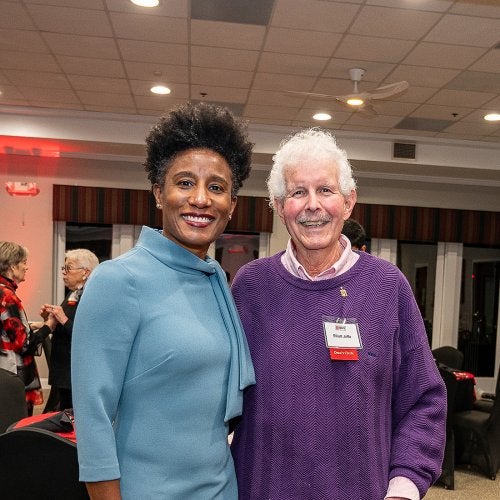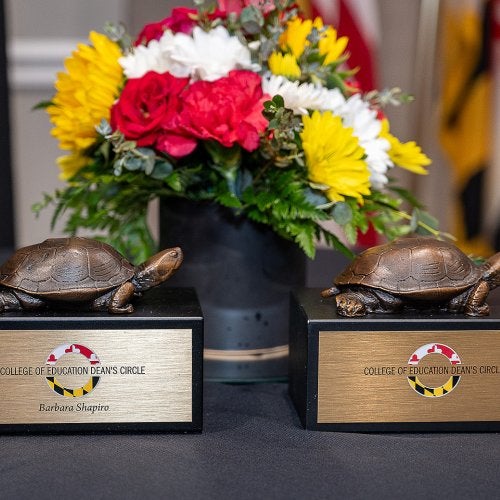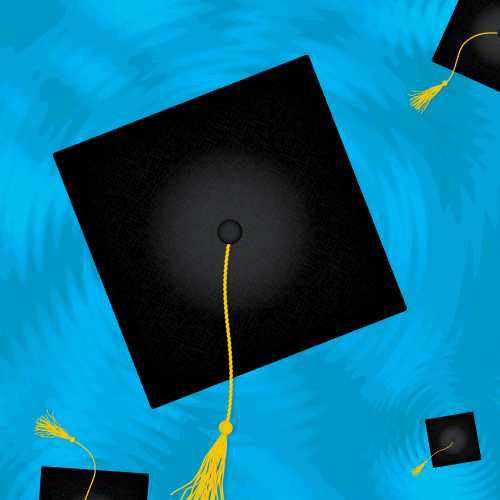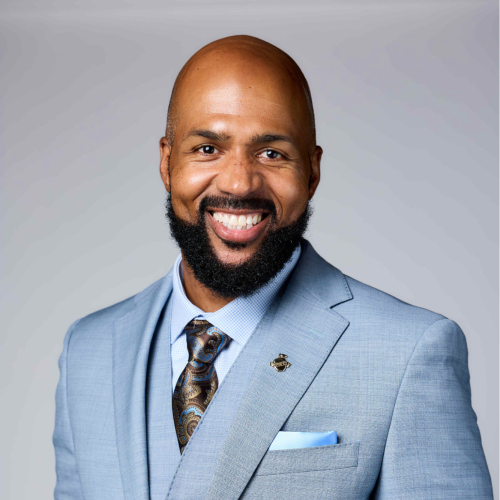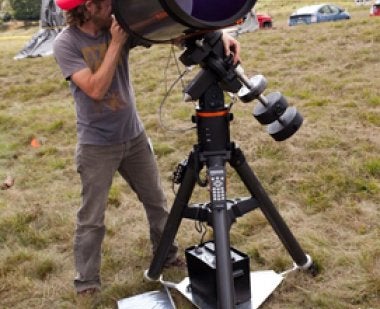
Bryan Curtis sets up his telescope in a field, 2012.
“One of my earliest memories was going to the theater with my father to see The Empire Strikes Back. I was about five years old, so it was real to me. I started looking up at the sky a lot,” says Bryan Curtis, an 8th grade science teacher at Greenbelt Middle School. “When I was 8, Dad bought a pair of binoculars and took me to Northern Virginia Community College, where we could lie out on the tennis courts stargazing. He pointed out constellations to me. I started getting serious about it when I was 10 or 11. Vastness fascinated me.”
Bryan’s early interest in astronomy turned into a lifelong passion and ultimately led him to teaching. A late-bloomer who pursued a career in music throughout his twenties, Bryan declared a major in biology when he first enrolled at the University of Maryland, but he soon found the competitiveness of science majors off-putting. His life changed, he says, when he volunteered for an outreach program to expose school-age children to the wonders of science. He fondly remembers giving kids a look through his telescope during an event at Howard County’s Columbia Library: “They asked about black holes and quasars, a lot of what-if questions. Kids love doomsday scenarios. It was an awesome experience, and it took me back to a place that felt really good.”
Encouraged by his wife, Bryan applied for the newly created Bachelor of Science in Middle School Mathematics and Science (MSMS), a program offered by the Department of Teaching and Learning, Policy and Leadership. There, he at last found the academic atmosphere he was looking for.
“From the moment I started at the College of Education, I realized it was where I needed to be,” Bryan says. “There was a totally different vibe. Collaboration was highly valued. It brought a rush of life into my student career. I felt like I had a voice again.”
“Voice” has proven to be crucial to Bryan’s teaching style. One of his foremost priorities, he says, is valuing the voices of his students – nurturing their stake in their education, acknowledging their curiosity rather than “shutting down” their questions, and making sure they do not withdraw mentally from a learning experience when their preconceptions are challenged. He says this collaborative approach to the classroom has made all the difference in building relationships with his students and fostering their commitment to learning.
“One day, during my first year,” Bryan recalls, “there was a fight in the cafeteria involving one of my students. When the kids returned to class after lunch, predictably they were upset and the fight was all they wanted to talk about. I didn’t really know how I should handle it, so I started writing on the board and taking the class through the warm-up exercise for the lesson. But one of my students asked, ‘Can we talk about what happened in the cafeteria?’ My first reaction was, ‘No, we’re going to have class,’ but then I stopped and realized that we should talk about it. So we had a discussion, and it was great.”
Bryan credits a College of Education instructor, Dr. Jessica DeMink-Carthew, with steering him towards a focus on student voice in “Students, Schooling, and Communities” (EDCI 297), a foundational scholarship-and-practice course in the MSMS program. The program pairs EDCI 297 with field experiences in middle schools during candidates’ sophomore year in order to give pre-service teachers insight about school structures, help them learn how to build connections with local communities, and develop their awareness of the backgrounds, needs, and expectations of students.
“Our discussions of student voice were especially concerned with middle school philosophy and instruction for adolescents,” Dr. DeMink-Carthew says of the course. “At that age, students start to develop their critical sensibilities and push back a bit more. So we examined how to create meaningful opportunities for student voice in the classroom – for instance, by providing students with bounded choices and letting them explore their own interests. Teachers are held to standards for the delivery of curricula, but we have to negotiate that with the actual human beings in our classrooms.”
“Middle school is an intensely social world, and teachers need to tap into that,” says Dr. Daniel Levin, the MSMS program coordinator and a clinical assistant professor in the Department of Teaching and Learning, Policy and Leadership. “We have to ask ourselves, what kind of social environment are we trying to create in schools?”
Bryan Curtis and 8th graders from Greenbelt Middle School took a field trip this year to the Smithsonian Institutes National Museum of Natural History. This photo was taken on the museums front steps.
For this reason, one cornerstone of the MSMS program is This We Believe, a developmentally responsive pedagogical framework created by the Association for Middle Level Education. The framework is designed to help teacher candidates think beyond course content and address adolescents’ particular needs within the context of their social and intellectual maturity. But this focus on “the whole child” also has an impact on pedagogy, Dr. Levin notes, especially when it comes to teaching in ways that connect students’ lives with what they are learning in class.
For science teachers, a persistent challenge is getting students to reconcile their prior knowledge about the natural world with scientific concepts, which sometimes are counterintuitive. One commonplace example is the false analogy that some people apply to the question of why the seasons change: working from the idea of closeness to a fire, they assume the Earth is closer to the Sun in summer and farther away in winter. Challenging this sort of assumption requires teachers to impart to students a frame of mind that critically posits, tests, and revises knowledge. This frame of mind is central to the practice of science.
According to Dr. Levin, the MSMS program focuses on giving teachers training in how to instill scientific practices in their students because these practices, not content knowledge per se, are what endure long after school. By this logic, ways of thinking about, discussing, and reasoning out the question “What is behind seasonal change?” are more important than the answer itself.
“We want our teacher candidates to be thoughtful about their subjects,” says Dr. Levin. “Our candidates study deeply, at the college level, exactly the content they will teach to schoolchildren, rather than the content that would make them leading experts in the discipline. A math major may study differential calculus, but for a middle school math teacher, it’s much more helpful to learn basic geometry backwards and forwards.”
For Bryan Curtis, mastering grade-appropriate content led to an apprenticeship in what he asserts is the most valuable teaching practice he acquired at the College of Education – the art of self-reflection.
“Dr. Levin taught me about anticipating students’ thinking,” Bryan says. “This makes a huge difference, not only in preparing to answer the questions they have but in probing my own understanding of what I’m teaching. Looking at course content from a kid’s perspective really helps you break it down.”
Another powerful influence for Bryan during his matriculation at the College was Christopher Ellis, his instructor for a course on cognition and motivation in reading (EDHD 426). He attributes to Chris his induction into plus/delta formative assessments, a qualitative evaluation tool whereby students regularly take stock of how well the class is doing in order to inform their teacher’s efficacy. Bryan also remembers Chris as a larger-than-life teacher, a role model for what kind of educator he wanted to become.
“Chris has fire in the classroom,” Bryan recalls. “He gave me the best advice I’ve ever heard as a teacher: wake up every day thinking you’re going to change the world.”
Bryan Curtis is an 8th grade science teacher at Greenbelt Middle School. He graduated with the first cohort of the College of Education’s Middle School Mathematics and Science program in 2014.
Dr. Daniel Levin, a clinical assistant professor in the Department of Teaching and Learning, Policy and Leadership, is the coordinator of the Bachelor of Science program in Middle School Mathematics and Science. He taught secondary science for nine years in public schools in the Washington, D.C. area. His research interests include responsive science teaching, formative assessment, socio-scientific issues, and students’ engagement in scientific practices.
Dr. Jessica DeMink-Carthew earned her Ph.D. in Teaching, Learning, Policy, and Leadership at the College of Education, graduating in 2015. During the last two years, she has served as partnership manager for the University of Maryland and College Park Academy. Most recently, she was appointed to an assistant professorship in Elementary and Middle Level Teacher Education at the University of Vermont, Burlington.
Christopher Ellis is an English and literacy content specialist at Benjamin Banneker Middle School in Rockville, Maryland. He earned both his B.A. and his M.Ed. in Secondary Education from the College of Education, where he also teaches.
